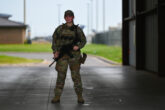June 27, 2018
How To Fix The Army’s Recruiting Crisis
Almost 17 years into Global War on Terror operations, the gulf that marks the familiarity gap between the military and society seems larger than ever.
Trends show a growing burden of conflict shouldered by a shrinking “warrior caste” of individuals who serve, as military service itself increasingly becomes a hereditary profession. A concurrent trend is a looming recruiting crisis given the small percentage of young Americans eligible, let alone interested, in serving. While economic forces heavily impact military recruitment, the broader trend of isolation of the military from society will continue to be an underlying factor. The Army has had to lower recruitment goals against the task to grow the force to 500,000 active duty soldiers despite growing opportunities among previously untapped sources of talent, such as women and marginalized groups.
To combat weakening connections between Americans and the military, the Army needs to take advantage of the branding void left in the wake of the “Army Strong” advertising campaign to shift the Army’s marketing focus from promoting personal advancement to strengthening public understanding. Clarifying what the military does and what it is will consequently create an environment where service is better understood and ideally expand interest in service.
Since the end of the draft in 1973 and the need to recruit an all-volunteer force, the Army-sponsored three prominent marketing campaigns employing commercials, flyers, and posters. The first campaign lasted almost two decades and depicted the Army as a place to “Be All You Can Be,” which sold the Army as an opportunity to learn job skills and earn money for college. “Be All You Can Be” marketed to the individual and promoted how the Army could improve a soldier’s standing in life. In 2001, “An Army of One” replaced “Be All You Can Be” to appeal to the perceived increasing individualistic streak in young people and further emphasized the difference a single person can make. “An Army of One” contradicted the focus on teamwork and unit cohesion inherent in the Army and was replaced in 2006. The new campaign, “Army Strong,” continued the strategy of self-actualization and self-improvement by drawing attention to the emotional and physical strength recruits could gain through service. Failing to resonate with the public, “Army Strong” was scrapped in 2015.
Read the Full Article at Task and Purpose
More from CNAS
-
National Security Human Capital Program
Short SupplyExecutive Summary The U.S. military faces a critical challenge: Fewer young Americans are willing to serve, and fewer adults are encouraging them to do so. Because of delibera...
By Katherine L. Kuzminski & Taren Sylvester
-
National Security Human Capital Program
Defending the Army’s Command Assessment ProgramThe concept for CAP — developed during the first Trump administration — benefited from the guidance, input and oversight from the foremost scholar and practitioner on military...
By Katherine L. Kuzminski
-
National Security Human Capital Program
‘Women Don’t Just Achieve…They Excel’: Fmr. Marine Corps Attack PilotDr. Kyleanne Hunter, former Marine Corps attack pilot and CEO of Iraq & Afghanistan Veterans of America, says “women are the fastest growing group of veterans” and “the fastes...
By Dr. Kyleanne Hunter
-
National Security Human Capital Program
A Workforce Strategy for America’s Shipbuilding FutureThe future of American maritime dominance will not be determined solely by the number of ships launched or contracts signed, but rather by the strength and sustainability of t...
By Katherine L. Kuzminski & Laura Schmiegel




